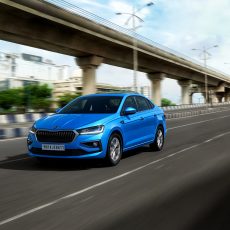 The advent of the new Hyundai Verna this year makes it imperative for us to pit it against its close competitors –the Honda City and the Volkswagen Vento. Read on to fi nd out which emerges the winner in this tussle
The advent of the new Hyundai Verna this year makes it imperative for us to pit it against its close competitors –the Honda City and the Volkswagen Vento. Read on to fi nd out which emerges the winner in this tussle
Story: Adhish Alawani
Photography: Sanjay Raikar
 If the year gone by was marked mostly by new hatchbacks in the Indian market, this year seems to be dominated mainly by sedans. From entry-level to premium – the Indian market sure seems to be graduating. It is also evident that
If the year gone by was marked mostly by new hatchbacks in the Indian market, this year seems to be dominated mainly by sedans. From entry-level to premium – the Indian market sure seems to be graduating. It is also evident that
mid-size sedans are the choice of many since these pack in everything in just the right proportion – size, performance, efficiency and, most importantly, the price. The Honda City had always been the topper in this segment until last year, when German giant Volkswagen introduced the Vento. The competition then became tough and, to make it even more interesting, Hyundai have come up with the new Verna this year, which looks strong enough to take on its competitors. Needless to add, it was inevitable that we should make these three vie with one another to find out which one had the potential to wear the crown.
Given the reliability of the Japanese, excellent engineering of the German and city-centred suppleness of the Korean, we were sure this contest would be packed with a lot of action. And so it was.
 From The Sketchbook
From The Sketchbook
There is no doubt that the Indian customer is driven by considerations of cost and efficiency more than anything else, but what come next on his list are the looks of a car. The vehicles under the scanner here evince completely different design theories. While the Vento is the most basic and plain of the trio, it still has its own character –a no-nonsense automobile with sharp, distinctive lines and edges. The Honda City has its arrowhead theory in place and looks extremely focused. With maximum aerodynamics in mind, the designers at Honda gave the City a look that is aggressive from every angle. Its bold grille and angular headlamps make it the most desirable.
Hyundai too score good points on the design front. The Koreans call it their ‘fluidic’ design theory that consists of naturally flowing lines. The Verna has surely gone a number of notches up from its earlier version so far as looks are concerned and now makes everyone on the road give it a second look.
With all the three cars having their own special styling, it becomes difficult to choose one. Ultimately, it all boils down to personal choice. The Vento suggests itself easily to someone inclined towards simplicity. The Honda City is for the aggressive ones and the Verna for those looking for a fresh look.

 Show ’Em What You Got
Show ’Em What You Got
The Hyundai Verna comes with three options in petrol, of which we had the 1.6-litre manual transmission variant on test. This motor is the most powerful and torquey of the lot with 123 PS of peak power and 158 Nm of peak torque. However, this power doesn’t translate to quickest outright acceleration from 0 to 100 km/h.
The Verna does it in 11.48 seconds, which is slightly better than the Vento, but 0.8 seconds slower than the City. Neither does the Verna impress us with its bottom end as it struggles to move in low revs. Nevertheless, the refinement of this Hyundai engine is exceptionally good. The engine is so silent, you have to nudge the accelerator pedal or check the tachometer at idling to check if the engine is really running. Similarly, the gear shifts are smooth as butter and add their bit to the overall smoothness of this car. The Honda City has a 1.5-litre engine, which is approximately 100 cc less than the other two. With 118 PS of peak power and 146 Nm of max torque, it’s not the best on paper. However, on road the City is the quickest of the lot from 0 to 100 km/h and also has the best-in-class roll-on figures. The Vento turns out to be the slowest of the three with just 105 PS of peak power from its 1.6-litre engine. The Vento’s refinement levels are low too.


 Dynamically Yours
Dynamically Yours
Coming to the drive quality and handling characteristics, there is no doubt about which one is the leader. The Volkswagen Vento has been the best in this regard since it first appeared on our roads and still continues to be so.
With its suspension sprung slightly on the stiffer side and a very well sorted chassis, the Vento manages to impress
with its superb road holding and stability. Push it through the corners at the highest speed possible and it just goes through without a hint of nervousness. Flick it through a series of opposite turns and there is hardly any roll. This is where the Vento feels far superior to the others.

 The Verna is more like a city car than anything else. Its softness is good for city driving and absorbs the bumps on the roads at slow speeds. However, take this car to the highway and it feels completely out of sync. Its soft suspension makes the car go all over the place at speedy turns. Considerable body roll makes for an uneasy drive through the zigzag sections. Add to that its extremely lightweight steering, which fails to give any feedback. The feel of being connected with the car is missing. Obviously, Hyundai have kept city driving as their main priority. But one cannot help feeling that the compromise that they have made is a little more than necessary. The City, on the other hand, feels at home both on city roads and highways. This Honda manages to strike the right balance between softness for city driving and stiffness for high speeds.
The Verna is more like a city car than anything else. Its softness is good for city driving and absorbs the bumps on the roads at slow speeds. However, take this car to the highway and it feels completely out of sync. Its soft suspension makes the car go all over the place at speedy turns. Considerable body roll makes for an uneasy drive through the zigzag sections. Add to that its extremely lightweight steering, which fails to give any feedback. The feel of being connected with the car is missing. Obviously, Hyundai have kept city driving as their main priority. But one cannot help feeling that the compromise that they have made is a little more than necessary. The City, on the other hand, feels at home both on city roads and highways. This Honda manages to strike the right balance between softness for city driving and stiffness for high speeds.

 Of Rupees And Paise
Of Rupees And Paise
Ownership and the running cost of a car are of utmost concern to the Indian customer. This consideration is foremost in any decision while buying a particular vehicle. This is where the Verna with its lowest price scores over the other two. With a tag of Rs 8.72 lakh (OTR, Pune), it is over Rs 50,000 cheaper than its competitors (the Vento is priced at Rs 9.26 lakh and the City at Rs 9.30 lakh).
Look at fuel-efficiency and maintenance cost and the Honda City brings a smile to your face. Its overall efficiency of 17.7 km per litre makes it the best of the lot. Japanese reliability and minimum maintenance cost push it further above its competitors. Whereas the Vento delivered an overall economy of 14 km per litre, the Verna stayed at the bottom with just 13.4 kpl.

 WHO WEARS THE CROWN THEN?
WHO WEARS THE CROWN THEN?
By now, we have a clear picture of each car’s strengths and weaknesses. The Vento boasts of strong German engineering that endows it with excellent drive, solid feel and phenomenal build quality. However, it lacks in outright
performance as well as effi ciency. The Verna is soft, making it disappointing on highways and the twisties. Besides, its poor bottom end makes city driving a bit painful. But it comes at a cheaper price and offers a number of options (at
a heavy price of over Rs 1 lakh), which include parking camera, additional four airbags, smart key and keyless ignition start button, etc. Lastly, look at the Honda City. It has got an optimum drive for comfort and sportiness. It’s the quickest in outright acceleration as well as in gear roll-ons. It has exceptionally good fuel-effi ciency and Japanese reliability.
Though the costliest of the lot, to us the City comes across as a perfect combination of everything one would want from a car in this segment and thus manages to retain its crown.
 GASHA’S PERSPECTIVE
GASHA’S PERSPECTIVE
IN BLACK AND WHITE
Hyundai scribbled their notepads full trying to strike a chord with a good idea like Verna before fi nally breaking the code with the new ‘fl uidic’ Verna. The car looks chic, its engine is refi ned beyond belief and it’s loaded with features like an F1 driver’s mind. Things sure looked exciting until the car met its rivals.
With typical Korean softness to its drive, the Verna feels easy on the foot within the city, but behaves like an untrained dog under leash on the highway. This is where both the Vento and the City score brownies. A steady Vento and confi dent City offer a better highway run than the Verna. Coming back to city driving, the Verna’s poor low end and, therefore, poor initial acceleration makes city driving a tough task. The City feels a mite better, but still fails to match the linear torque delivery of the Vento. So let’s face it, unlike the Verna and the City, the Vento does feel heavy on the foot in traffi c. Whereas the park assist really comes very handy, poor visibility from the rear (due to extremely angled rear glass and high head-rests on the passenger seat) and absence of seat height adjustment
disappoint a little in the Verna.
So the verdict of this shootout lies in your age-group.Young, enthusiastic drivers, who likes to take their car out for a long run every weekend will be disappointed by the Verna’s poor stability at high speeds. Vento comes to the rescue there. For middle-aged women, who want a powerful car for city driving, the City is a perfect blend of power and comfort. And for the fashionable ladies, who put style, features and comfort above everything else, the Verna is a fresh face in the market.




